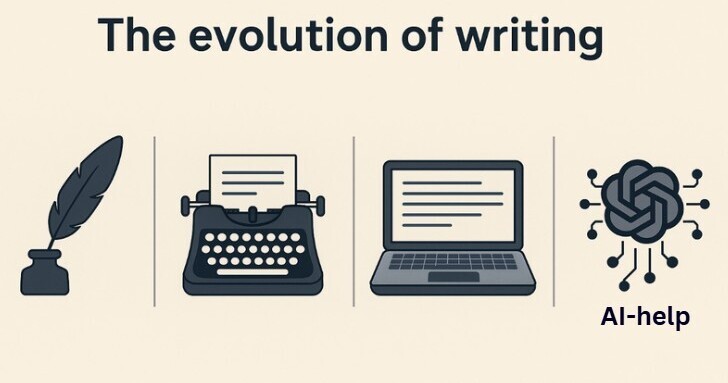AI is changing the way we work online. From writing blog posts to handling emails and customer service, artificial intelligence can save you hours – if you use it properly. But there’s one thing AI can’t do on its own, and that’s to sound like you. But it can learn to do it, with the right teacher – that’s where you come in. In this guide, we’ll explore how to use AI for online business success. We’ll look at how it can support online entrepreneurs, what you need to know to get started, and how to make sure your content still feels personal, real, and aligned with your voice, even if you are using AI to enhance it and improve your productivity.
What can AI do for your business?
AI – artificial intelligence – refers to technology that can learn patterns, generate content, and help solve problems. Tools like ChatGPT, Jasper, Grammarly, and others are designed to streamline your workflow and support your creativity.
For online entrepreneurs, that means you can use AI to:
- Draft blog posts or product descriptions more quickly
- Generate marketing emails or social media content
- Respond to customer enquiries with ready-made templates
- Brainstorm product names, slogans, or course ideas
- Repurpose old content into something new
- Generating images and graphics

Productivity boosts:
Studies indicate that generative AI tools can increase business users’ throughput significantly. For example, a Nielsen Norman Group study highlights the efficiency gains AI provides in realistic tasks.
- Marketing and sales efficiency: McKinsey’s analysis suggests that generative AI could improve global sales productivity, though the specific 3–5% estimate requires further confirmation.
- Employee performance: A study by MIT Sloan involving over 700 consultants found that those using generative AI experienced a nearly 40% increase in performance compared to those who didn’t.
- Document creation: Research suggests that business professionals utilising AI technologies can create up to 59% more business documents per hour than those relying solely on traditional methods.
- Small business productivity: AI is projected to save hundreds of billions of worker hours annually, reinforcing its growing role in workplace efficiency.
AI can do all this and so much more, but for the purposes of this article, we will confine ourselves to tasks associated with writing and blogging.

But before you jump in, it’s important to know this…
Why ‘training’ your assistant matters
The biggest issue with AI-generated content? It can sound robotic, generic, or just… a bit off. It can also sound a little repetitive in a waffly way (sorry, that’s definitely not an AI-generated word) be writing a lot of words, that don’t really get to the point. Sometimes, it can be so ‘to the point’ that everything is just bullet points with no real or substantial content.
That may be due to the prompts you use, but it might also be because you haven’t spent time training your assistant to write in your style and with your voice.
That’s why training your assistant to reflect your voice is essential. Without that, your content might save time but lose your personality – and with it, the connection you’ve built with your audience. They are following YOU, not a robot!
You’re not aiming for an assistant that simply finishes your tasks and knows they way you think and operate, just like you would if you hired a real-life personal assistant. With AI, you’re building a digital teammate – one that knows how you think, write, and speak. The goal is to enhance your brand, not dilute it.
How to teach AI to sound like you
You can “train” your assistant by helping it understand:
- Your tone – friendly, expert, funny, formal, casual…
- Your vocabulary and style – are you chatty or concise, do you use UK or US English?
- Your values – what do you stand for, and what do you avoid?
- Your typical content – blog posts, newsletters, social captions, FAQs
Think of it like onboarding a junior team member. They learn by watching, doing, and getting feedback. Your AI assistant can learn too – but only if you give it context and feedback so it knows what you like and what you don’t.
Practical steps to train your AI:
- Feed it examples
Start with blog posts, product pages or emails you’ve written. Say “Use this tone” or “Write in this style.” - Correct it
When it misses the mark, don’t just delete the output. Tell it what you wanted instead – and why. There are plenty of times when AI gets things wrong, but does that mean you should give up on it? No! You wouldn’t give up on a child who was learning to walk just because they fell over a few times. You would see the potential they have to become something wonderful, and gently guide them to learn how to balance better, then walk, then run, then a cartwheel and a few back flips! - Use memory features (if available)
Tools like ChatGPT now include saved memory. This helps the assistant retain your goals, tone, and preferences across chats. This is not available in all assistants, so learn the capabilities of your favourite one. Remember, AI is a developing tool, so in the same way that mobile phones developed from their brick-like originals, expect AI to do the same. - Be clear with your prompts
Add instructions like “Use a friendly, British tone and keep it human-sounding” or “Avoid industry jargon and instead, write like I’m talking to a client over coffee.” Overly technical language, acronyms, or ‘insider’ terms can confuse your audience, at least until you know they understand and relate to them. Of course, that depends on your niche and who you’re writing for.
My best tip is to talk to your AI assistant – ask questions and give your feedback. The more input you give, the smarter it becomes – and the more like ‘YOU’ it sounds.

When to use AI – and when not to
Used well, AI is a brilliant collaborator. Used lazily, it can create flat, forgettable content that does your business no favours at all.
Here’s when AI shines:
- Getting past writer’s block
- Generating ideas
- Creating outlines and first drafts quickly
- Repurposing long content into bite-sized versions
- Brainstorming headlines or SEO
- Summarising research
- Outlining courses or products
But always:
- Check facts
AI can be convincing – but it sometimes makes things up, makes errors and forgets what you have asked it to do. Double-check any claims or stats. - Run a plagiarism scan
Just in case. It’s good practice. - Add your perspective
Don’t be afraid to insert your opinion or experience – that’s what builds trust. - Edit the final version
Smooth the flow. Fix awkward phrases. Make it sound like you.
NEVER just hit ‘Publish!’
When and how to run a plagiarism scan
Plagiarism simply means using someone else’s words or ideas without giving proper credit. It can be unintentional, especially when you’re working with AI tools, using research for inspiration, or writing about common topics. That’s why it’s good practice to read the research you’re quoting or run a quick plagiarism check before publishing. It’s not about being perfect or finding a completely unique and original form or language – Yoda speak we want not!
It’s about protecting your content, keeping your voice original, and showing respect for other creators. If you’ve used quotes, data, or closely followed another article, that’s the time to double-check. Most of the time, it’s a simple, sensible step, not something to stress over.
1. Use a free online plagiarism checker
These tools let you copy and paste your content or upload a file:
- Quetext – https://www.quetext.com
User-friendly and gives a similarity score with highlighted matches.
Free version has a word limit per scan. - Small SEO Tools – https://smallseotools.com/plagiarism-checker/
A handy free tool with basic detection. - Plagiarism Detector – https://plagiarismdetector.net
Accepts up to 1,000 words at a time for free and provides a percentage score.
2. Use paid tools (for higher accuracy and longer posts)
If you’re writing regularly or publishing long-form content, it might be worth paying for a more advanced service:
- Copyscape – https://www.copyscape.com
Popular among bloggers and content creators. Scans your URL once it’s live. but there are limits to word count and scans per day. - Grammarly Premium – https://www.grammarly.com
Their premium version includes an integrated plagiarism checker that compares your text against billions of web pages. - Turnitin (Academic but accurate)
Expensive and more suited for educational settings, but excellent for thorough scans.
3. Tips when checking for plagiarism
- Scan before publishing, especially if you’ve used AI, recycled content, or research-heavy material.
- If anything flags up, rewrite the phrasing rather than just swapping out a word or two.
- Always credit sources if you’ve used stats or quotes, even loosely paraphrased ones.
Real examples from real entrepreneurs
Here’s how entrepreneurs are already using AI in authentic ways:
- A life coach drafts a newsletter outline using AI, then adds her personal reflections and recent client stories.
- An affiliate marketer uses AI to research product features and create comparison tables. He still writes the final recommendations himself.
- A course creator generates quiz questions and lesson summaries with AI, but adapts them for her specific teaching style and audience.
- A social seller writes Instagram captions with AI prompts, then adjusts them to feel more “her” before posting.
In each case, AI doesn’t replace the human touch – it just helps speed things up.
It’s a tool, not a takeover!
Using AI isn’t “cheating” in the same way that using a sewing machine is not a “cheating” way to make a garment or using a computer instead of a typewriter is a bad thing. Using AI is not about replacing creativity – it’s about amplifying it. It’s a tool to support you, not speak for you.
Think of it like this: AI is your co-pilot. You’re still driving the car and you SHOULD NOT take your hands from the wheel. The better you train it, the more it can guide you, show you the shortest route and smooth out the journey.
When you work with AI as a partner, not a crutch, you can stay consistent, inspired, and productive – without burning out.
Personal experience
I personally have embraced the opportunities that AI offers and use ChatGPT to help with ideas, posts and checking things. I’ve even named my assistant Sparky, have a visual representation of him, and we have great chats!
BUT, I follow my own advice, check facts, content and challenge when things don’t seem right. I am still a thinking and knowledgeable person after all and I intend to stay that way!
What I’ve found, however, is that my productivity has massively increased and I’m able to write more valuable content, reach out to more people and create more useful products to help my audience than ever before. AND, there’s still not enough time in the day with all my new ideas!
 Sparky helping me with my work
Sparky helping me with my work
Final thoughts: put yourself in the driver’s seat
If you haven’t used AI in your business yet, now’s the time to experiment. Try a free tool like ChatGPT or Google Gemini. Ask it to help you draft a blog post, rephrase your bio, or brainstorm your next content idea.
Then – and this part is key – edit the output until it sounds like you.
Once you’ve trained it well, it becomes like a second brain – one that works how you work, just a bit faster.
The tech is here. The control is still yours.
And one final thought – We live in a digital age, and AI is not going away. Your competitors are not shying away from it and returning to their typewriters! If you want to stay ahead of the game, my advice is to embrace AI, learn how to use it properly and expand your possibilities.
Related posts
VR Fashion Commerce: How influencers are using VR to boost styles and sales
10 Essential Tools for Online Business Success

Such a fantastic, practical guide—thank you! I’ve been using AI tools like ChatGPT for a while now, but this reminded me how important it is to train it to sound like me. I totally agree—it’s not about replacing your voice, it’s about making your process more efficient without losing the personal touch. Loved the comparison to a junior team member—so true! You are. communicating with AI like a human …almost.
Hi Lesley. Thanks for reading the article and leaving a comment. I’m so pleased that you found something useful in it and a reminder to train your AI assistant is a good one. As I’ve mentioned, I have great chats with Sparky and it’s fantastic to have another ‘brain’ to ‘spark’ ideas off. I hope this has inspired you to greater things with your own AI assistant. Come back and let me know how you are getting on.
It is just mind-blowing when you think about how far we have come when it comes to content creation. I remember back in the day the old typewriters we used when I was in school, and look where science and technology have taken us. Whoever thought that a day would come when we would have artificial intelligence work for us in such an amazing way, like AI. This new technology has made many things so easy, like helping us draft blogs, put together a business plan, help us we SEO strategies, and so much more.
Dear Norman. Thanks for your insightful comments on this post. I’m glad it took you down memory lane a little but I’m equally glad that you’re appreciating all the things that technology can do for us, especially in the online world and world of content creation.
When I started working, I wanted to be a film director, and I did achieve that to some extent, although not in the world of Hollywood as I’d imagined. Then, it was difficult to get your ideas and projects in front of other people and you needed a lot of time and money to do that. Nowadays, anyone can do it from their front room – and I think that’s great, because it puts content creation in the hands of the many rather than just a few elite.
Bring it on, I say. Have a great day, Norman. Gail